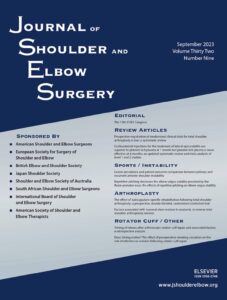Publications

Comparison of the activation and mechanical properties of scapulothoracic muscles in young tennis players with and without scapular dyskinesis: an observational comparative study
Authors: Volkan Deniz 1, Aylin Sariyildiz 2, Bilgihan Buyuktas 3, Sibel Basaran 2
Affiliations:
- Department of Physiotherapy and Rehabilitation, Tarsus University Faculty of Health Sciences, Mersin, Turkey
- Department of Physical Medicine and Rehabilitation, Cukurova University Faculty of Medicine, Adana, Turkey
- Department of Physical Education and Sports Teacher, Cukurova University Faculty of Sports Sciences, Adana, Turkey
Journal: Journal of Shoulder and Elbow Surgery - January 2024, Volume 33, Issue 1, Pages 192-201 (DOI: 10.1016/j.jse.2023.07.016)
-
Field & Applications:
- Medical
- Sport
- Musculoskeletal disorder
- Muscle development / Performance
Background: In tennis athletes with scapular dyskinesis the activation of the scapulothoracic muscles during serve is not known. Also, the mechanical properties (tone, elasticity, and stiffness) of the scapulothoracic muscles of the tennis athletes with scapular dyskinesis are likely to change. The study aimed to evaluate the activation of the scapulothoracic muscles while performing tennis serve and to determine the changes in the mechanical properties of the same muscles in young tennis athletes with scapular dyskinesis.
Methods: Seventeen tennis athletes with scapular dyskinesis aged between 11 and 18 years (the scapular dyskinesis group) and age and gender matched 17 asymptomatic tennis athletes (the control group) were included in the study. Activation of scapulothoracic muscles (descending-transverse-ascending trapezius and serratus anterior) in the three phases (preparation, acceleration, and follow-through) of the serve was evaluated using surface electromyography and mechanical properties of the same muscles were measured at rest by myotonometry.
Results: Ascending trapezius activation in the follow-through phase was lower in the scapular dyskinesis group compared to the control group [mean difference 95% CI: -22.8 (-41.2 to -4.5)], (p= .017). The tone and stiffness of the transverse trapezius (p= .043 and p= .017, respectively) were higher whereas the same parameters of the ascending trapezius were lower (p= .008 and p= .010, respectively) in the scapular dyskinesis group compared to the control group.
Conclusion: Activation of the ascending trapezius and the tone and stiffness of the transverse-ascending trapezius were altered in tennis athletes with scapular dyskinesis. Implementations to improve these changes can be included in the rehabilitation or training programs of young tennis athletes with scapular dyskinesis.
Keywords: electromyography, muscle activity, overhead sports, scapular dyskinesis, tennis serve, viscoelasticity
The activation of AT was lower in the follow-through phase of the serve and the tone and stiffness of the TT were higher, while the same parameters of the AT were lower in tennis athletes with scapular dyskinesis compared to their gender and age matched tennis athletes. Whether the results obtained from the current study could be utilized for all types of scapular dyskinesis is uncertain. Further studies with a homogeneous type of scapular dyskinesis are required to verify these results in tennis players with different type of scapular dyskinesis. Based on the changes observed in the activation and mechanical properties of the scapulothoracic muscles, therapeutic approaches to improve these variations should be included in the rehabilitation or training programs of the tennis athletes with scapular dyskinesis.


